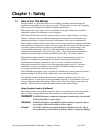Conveying System Mechanical Components Chapter 2: Functional Description 16 of 138
Basic System Types
Time-Fill Systems
A time-fill system conveys material to an on-line vacuum receiver for a pre-set time period.
When this interval elapses, the controller conveys material to the next on-line vacuum
receiver.
Volume-Fill Systems
A volume-fill system conveys material to an on-line vacuum receiver until the material level
activates the proximity switch in the vacuum receiver, or a preset time elapses. When either
of these conditions occur, the controller conveys material to the next on-line vacuum receiver.
Conveying Distance
Vacuum hoppers and Low Head Separators are installed over the material delivery point.
The Vacuum Power Unit and material pick-up device, however, can be installed some
distance from the delivery point. This distance is dependent upon the power unit chosen and
the total equivalent feet required to convey the material.
The manufacturer’s Engineering Department can advise you on your system’s capabilities
given the system make-up, distance, material and desired conveying rates.
Equipment Cycle
Our bulk material conveying systems are used for automatic pneumatic handling of most
free-flowing, dry, pelletized, powder granular materials. Add a Low Head Separator, and
fine powders can be conveyed. Most systems are custom designed using standard
components.
A positive displacement blower draws air through the non-reversing valves on the Vacuum
Power Unit. (See Figure 42 on page 105).
The vacuum is drawn through a filter chamber to prevent material from reaching the blower.
Signals from the programmable controller shift Sequence-“T” Valves to direct the vacuum
through the station being filled to a material pick-up device.
Material is sucked into a pick-up device and through the material tubing to the vacuum
hopper or Low Head Separator, mounted or suspended over a storage bin or processing
equipment.
When the vacuum hopper is filled or the convey cycle times out, the convey cycle ends. The
Vacuum Power Unit immediately shifts into blowback, dumping the material in the vacuum
hopper.
The blowback cycle backflushes air through the vacuum tubing to clean the filter chamber.
The blowback feature cleans the filter chamber after each loading cycle and speeds emptying
of the vacuum hopper. This operation is continuous and automatic. (See Figure 43 on page
106).
The programmable controller automatically shifts the appropriate sequence “T”-valves and
starts the loading cycle at the next station in the cycle.
The cycle continues until the programmable controller senses, through level sensors at each
station, that all stations are filled.


















